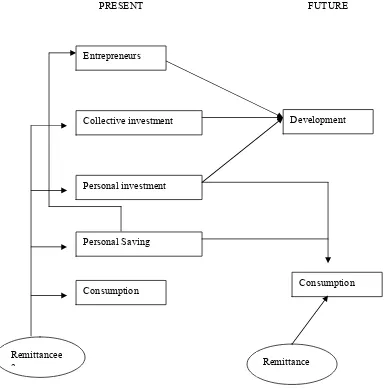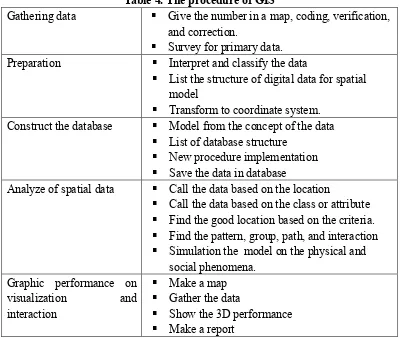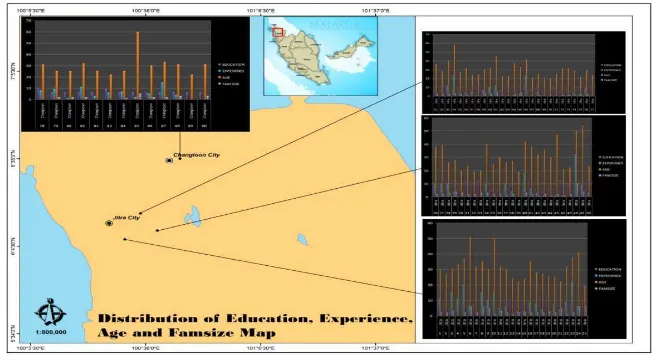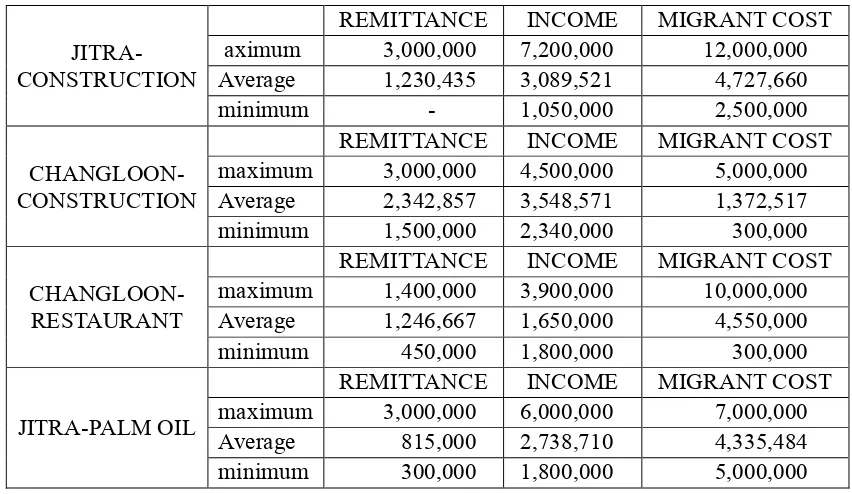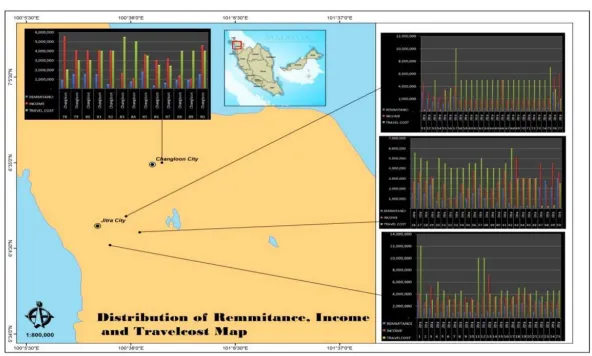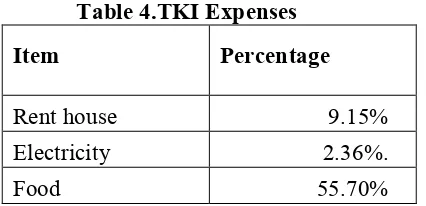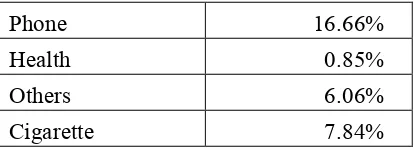The Welfare of the Indonesian Migrant Workers (TKI) in the Land of a
Malay Nation: A Socio-Economic Analysis
By:
Izza Mafruhah, Totok Sarsito, and Evi Gravitiani
(Universitas Sebelas Maret, Solo, Indonesia)
Abstract
The aim of this research is to find out whether the welfare of the Indonesian migrant workers (TKI) working in Kedah, Malaysia, increases. There are three special targets which the researchers want to reach: (1) to identify and to map the location of the Indonesian migrant workers (TKI) working in Kedah, Malaysia, (2) to analyse their social and economic condition, and (3) to identify their problems met during they work in the location. The methods used are spatial and regression method. Geography Information System (GIS) is used to map the location of the Indonesian migrant workers (TKI). Regression method gives information of primary factors of the Indonesian migrant workers (TKI) that can increase their welfare. Spatial analysis is divided by three themes of map: (1) work type, (2) education, experience, age, and family size, and (3) remittance, income and migration cost. Socio-economy condition of the Indonesian migrant workers (TKI) is good enough. Other important finding is that the Indonesian migrant workers (TKI) mostly spend their money for phone deposit and cigarettes. Remittance is a proxy of the Indonesian migrant workers (TKI) welfare. It is significantly influenced by income, education level, family size, and living cost. Meanwhile, age, experience, and migration cost do not influence the remittance.
Keywords: TKI welfare, spatial analysis, socio-economy condition, remittance
A. Introduction
1. Indonesian Labor
In the year of 2012, the total number of unemployment in Indonesia is around 7.61 million (6.32%). Whereas the growth of workers is around 2.91 million per year and the available job is only 1.6 million per year, so the gap between the growth of workers and the available job is 1.3 million. Based on their education background, 20% of the Indonesian workers completed their elementary school, 22.6% completed their junior high school, 40.07% completed their senior high school, and 9.7% completed their undergraduate study.
Table 1.1. Amount of TKI, 2006 – 2009
Year Amount
GENDER STATUS
Male Female Formal Non-formal
Amount % Amount % Amount % Amount %
2004 380,690 84,075 22.08% 296,615 77.92% Not available Not available Not available Not available 2005 474,310 149,265 31.47% 325,045 68.53% Not available Not available Not available Not available 2006 680,000 138,000 20.29% 542,000 79.71% 177,495 26.10% 502,505 73.90% 2007 696,746 152,887 21.94% 543,859 78.06% 196,191 28.16% 500,555 71.84% 2008 748,825 200,188 26.73% 548,637 73.27% 269,346 35.97% 479,470 64.03% 2009 632,172 103,188 16.32% 528,984 83.68% 103,918 16.44% 528,254 83.56%
TKI’s destination countries are shown in Table 1.2.
Table 1.2. TKI’s destination countries and the amount
No. Destination Countries Amount
1. Malaysia 222,198 2. Singapura 37,496 3. Brunei Darussalam 5,852 4. Hong Kong 29,973 5. Korea 3,830 6. Jepang 96 7. Taiwan (RRC) 50,810 8. Arab Saudi 257,217 9. Kuwait 25,756 10. Emirat Arab 28,184 11. Bahrain 2,267 12. Qatar 10,449 13. Jordan 12,062 14. Oman 7,150 TOTAL 693,340
Source: ILO Report, 2009
Malaysia and Singapore are the countries choosen by TKI. Similarity in culture and religion is the reason why almost all TKI prefer working there. Saudi Arabia becomes another choice for a religious reason. TKI prefer working in Hongkong for the distance and high income, comparing to East Middle countries.
Low income per capita countries in South East Asia (ASEAN) are in great quantities of labor supply. Based on Labor Migration Report (2009) [2], migrant labor in ASEAN is 14,799,713 people. Filipina is the highest labor supply, 8,233,172 people. Indonesia is 2,700,000 and Myanmar is 1,840,000. Filipina’s workers have high education level and work in formal sectors. Meanwhile, workers from Indonesia and Myanmar have relative low education level, so most of them work in informal sectors. It influences on their welfare.
2. National Agency for the Placement and Protection of Indonesian Migrant Workers (BNP2TKI)
enough knowledge of law and communication, especially in non-formal sectors. In order to give protection to them the Government of Indonesia then issued Act number 39/2004 about “Placement and Protection of TKI.” The act is important due to a number of reasons, such as:
a) Labor has the same of rights and chance without discrimination to obtain good job and income in or outside Indonesia. It is fit to their skill, trace, interest, dan ability.
b) Placement of Indonesia migrant workers is an effort to actualize right and chance for labor to obtain good job and income. The implementation watches
human right and law protection and distribution of labor demand and supply. It is based on national regulation.
c) Government obligatory and protect human right who work in or outside the country. It is based on human right, democration, social justice, equality and equity of gender, anti-discrimination, and anti bullying.
d) Placement of Indonesian migrant workers is integrated between government and society in good regulation system to protect migrant workers abroad.
This regulation completely regulates the procedure of Indonesian migrant workers and forms national agency for placement and protection of Indonesian migrant workers (BNP2TKI). This agency aims are ensure on placement and protection for Indonesian migrant workers (TKI) in foreign countries. Main duties BNP2TKI are services, coordinates, and controls in 1) documents of TKI, 2) provisioning for TKI departure, 3) problem solving, 4) source of budgeting, 5) TKI departure and return, 6) TKI quality improvement, 7) information, 8) agency quality improvement, 9) TKI and their family welfare improvement. In some area, BNP2TKI has a branch office which works with labor agency in the area, province and regency. TKI protection is also on BNP2TKI authority. This agency makes collaboration with Ministry of Foreign Affairs. The cases are TKI illegal, who works abroad without exit permit, and also TKI at the end of their contract period. Malaysia and Arabia are the countries which have problem with TKI because the amount of TKI in these countries is big enough.
TKI receives training for higher income in destination countries. BNP2TKI has cooperation with a number of governments, such as South Korea, Japan, and Hongkong, as destination countries. Another TKI placement is done by private company (PPTKIS). This company searches another chance to TKI placement, but it is under BNP2TKI control.
3. Welfare of TKI
entrepreuners. But, it would depend on how they use their remittances in their origin area in Indonesia.
The success of TKI in their future life would depend on the placement, life pattern, and the environment around where they live. This research conducts survey on TKI placement in Kedah, Malaysia to know their life in detail.
B. Objectives of the Research
The improvement of TKI’s welfare is the major issue of this research. The aims of this study in the first year are:
1. To analyse and to map the TKI in Kendal (Indonesia) and Kedah (Malaysia); 2. To Identify the problem met by the TKI working in the Palm Oil Plantation in
Kedah (Malaysia);
3. To analyse the TKI’s welfare;
4. To analyse the socio-economic condition of the TKI in Kedah;
5. To formulate the policy implication of the central and regional government of Indonesia for the improvement of the TKI’s welfare.
The study is conducted in cooperation with a team of research coming from Universiti Utara Malaysia as a counterpart. only has permission letter from 2 palm oil plantantions. In research plan, this study will conduct in 8 palm oil plantations. The plantations are Perkebunan Risda Kedah and Perkebunan Genting Jitra Kedah. The amount of respondent is 43 people only. To fulfill an adequate amount of respondent, this research is also conducted for TKI who lives in Kedah, not only limited in plantation. It makes good step for the result, because researcher knows life pattern of TKI completely. It gives influence in the study aims, there are:
1. Identifying and mapping TKI location in Kedah 2. Analysis of TKI socio-economy condition in Kedah 3. Identifying TKI problems in Kedah
4. Formulating government policy implication on TKI welfare improvement.
C. Track Record of PPKDK LPPM UNS in Conducting Joint Research
Sulawesi Selatan, 2011; (7) Analysis of TKI Problems in Sragen Regency, 2011; (9) Problem Solving of The Global Financial Crisis Impact for TKI, 2011.
All of the researches were conducted by PPKDK LPPM UNS in cooperation with Higher Education Directorate, Community Welfare Ministry, and also National Service of Placement and Protection of Indonesia Labor (BNP2TKI). The results are almost all of TKI are not in better condition, in the long run. It means TKI can’t increase the welfare continuously and permanently. This condition will make the vicious circle longer.
This collaboration research will be focused on the welfare of TKI working in Malaysian palm oil plantation, first by identifying problems and then finding solutions. Solution of the problems should be based on the roots of the problems. This study is meant to contribute model for eradicating poverty, matching to the UNS road map.
D. Literature Review 1. International Migration
Migration is a reflection of divergence of the economic growth and uneven-spread of the development. The high economic growth gives higher expectation for the worker. It causes high migration in several areas in Indonesia, from low to high economic growth of the region.
Old concept of migration is migration among region or area in one country only. In 1980s, the new concept of international migration is defined:
1. Migration is permanent people movement from one region to another region. 2. Type of migration is the classification based on spatial dimension and time
dimension.
3. International migration is people movement from one country to another country.
4. Internal migration is people movement from one region to another region in one country.
Based on time dimension, migration can be defined as:
1. Seasonal migration is people movement from one region to another region but not permanent.
2. Commuter migration is people movement from urban area to city/central bussines district (CBD) for study or regular work, and vice versa.
Migration theory is known by Ravenstein, and continuing by Lee, Zelinsky, Mantra, Kasto and Keban. Their theory says that people migrate because of the need and the stress. Theory of stess-treshold or place utility model says that stress will occur to people who are unable to fulfill their greater need. People will move away or migrate if their stress is in the treshold, and they fail to fullfil their hope or need.
2. Indonesian Migrant Workers
Unemployment and poverty, inadequate infrastructure, a complicated regulatory environment, and regional inequality are all push factors driving international migration. The number of migrant workers deployed from Indonesia is rising and has reached 632,172 in 2009. Adding to this is the large number of irregular migrants leaving the country without going through the formal recruitment scheme. Indonesia is now recognized as having the second largest migrant worker population in South-East Asia, second only to the Philippines. Indonesian migrant workers, the majority of whom are women (79%), are mostly employed in Asia (59%) and the Middle East (41%). Most migrant workers are employed in the informal sector (77%) mainly as domestic workers or labourers.
In Asia, Indonesia is one of three countries (together with the Philippines and Sri Lanka) which deploy more female than male migrant workers. This figure is mainly influenced by the relative number of deployments to Malaysia and Saudi Arabia, which together accounted for 86 per cent of all deployments in 2004. Women generally constitute between 40 and 50 per cent of the workers deployed to Malaysia but more than 90 per cent of those sent to Saudi Arabia. The latest statistics indicate that 75.3 per cent of all workers deployed in 2006 were women. Most migrant workers from Indonesia have low levels of education and work in unskilled or semi-skilled occupations. Men mostly work in agriculture, construction or manufacturing while the great majority of the women are domestic workers or caregivers.
The 2004 law on Placement and Protection of Indonesian Overseas Workers is aimed at: bringing about better migration management, including improving the qualifications of workers and reducing the number of illegal and undocumented workers; establishing institutional mechanisms for the placement and protection of migrant workers; conducting advocacy on their behalf; and applying administrative and penal sanctions for breaches of its provisions. The Government is also working to enhance support services in destination countries, develop a more accessible mechanism for support services, improve data collection and improve cooperation among Government agencies.
Law No. 39, promulgated on 18 October 2004, is the basic law that governs and regulates international labour migration from Indonesia. It was envisioned to:
b) give effect to a provision of the 1945 Indonesian Constitution assuring every citizen of the right to employment and a decent living, including the right to be protected while in the exercise of such right, particularly when overseas.
The explanatory note of Law 39/2004 (Placement and Protection of Indonesian Workers Abroad) provides the rationale for the law – that limited employment opportunities in the country have caused numerous Indonesian citizens to seek work abroad, but in so doing could be exposing themselves to the risks of inhumane treatment before, during, and after return to Indonesia. The law likewise defines “placement service” to be one that is “cheap, quick, uncomplicated, and safe”, as opposed to other means, that might be considered “illegal placements” or even trafficking. The law also provides the benchmarks and minimum standards necessary for the evaluation and assessment of the implementation of its provisions.
Lack of knowledge and awareness of migration procedures, migrant rights and the issue of trafficking in general, makes many victims vulnerable to trafficking throughout Indonesia. At the local level, in particular, where the trafficking process begins, migrants are easy prey for traffickers making false promises about job offers. The Government of Indonesia has shown a commitment to preventing and combating trafficking. In 2007, comprehensive anti-trafficking legislation was passed to address the issue and provide victim assistance and protection. Progress, however, is stymied by the scale of the problem in the country and the region as a whole.
There are two major system of migration have evolved, first the official system or Government to Government ( G to G ) with South Korean, Japan, and Hongkong.
Second Business to Business ( B to B system ) on Malaysia, Singapore and Middle East . The most migrants are women working as domestic servants. Migrants to Singapore are both men and women working in services and construction, while most migrants to Malaysia are male construction and plantation workers in low status, poorly paid jobs.
3. Indonesian Migrant Workers (TKI) in Malaysia
Malaysia is both an origin and a destination country of migrant workers. Despite its economic success in almost all sectors in the last 15 years, Malaysia has experienced structural shortage of labour supply in a number of sectors. As of the end of December 2008, out of a total of 2,062,596 foreign migrant workers in Malaysia, Indonesian workers constituted 52.6 per cent (1,085,658). There is also a large number of irregular Indonesian migrant workers in Malaysia. Indonesian workers are mainly found in certain occupational sectors, such as domestic work (24.83%) and plantation work (25.33%). They tend to dominate. For the past decade, the Malaysian government has made a conscious effort to reduce dependency on foreign workers from a particular country by practicing diversification. As a result, the share of Indonesian workers has dropped over the past few years.
(abroad) (27%) and difficulty in finding a job in Indonesia (21%). Majority had paid recruitment fees, with the average amount for those paying in Indonesian rupiah being IDR 5.3 million (USD 353) and for those paying in Malaysian ringgit being RM 2,838 (USD 806). To finance the initial migration costs, 70 per cent of workers borrowed money from their own family to cover the pre-departure expenses. However, service workers (58%) and domestic helpers (53%), occupations dominated by female workers, relied more on parties other than their family members to finance their migration costs.
4. Remmitances
Remittance can refer to the accounting concept of a monetary payment transferred by a customer to a business. People can exile and send an allowance on condition that they did not return home. A remittance is a transfer of money by a foreign worker to his or her home country. It gives positive impact for remittance man’s native region. Remittances are playing an increasingly large role in the economies of the region, contributing to economic growth and to the livelihoods of less prosperous people. Now days, remittance tends to use for consumerism. It will more useful if remittance is used for productive activities.
Figure 2.1. Remittance and Economy Development
The figure shows relationship of migration, labor market, and Indonesian economy condition. Remittance uses for consumption, individual saving, and investment. Saving and investment give positif influence in economy development.
5. Previous Researches
Moniaga, 2008, had a reserach about Indonesian Domestic Migrant Worker and find Most of the female migrant workers have low education level, generally only up to
Entrepreneurs
Collective investment
Consumption Personal investment
Personal Saving
Consumption Development
Remittancee e
PRESENT FUTURE
primary school, and they come from villages where there is a lack of employment opportunities. The official records state that the ages of the workers are between 18-40 years. However, they can also be girls as young as 14 who travel with falsified passports and other identity documents. The primary reasons, including the push and pull factors, for seeking work abroad as domestic workers can range from:
a. Job opportunities overseas are more lucrative (higher wages) b. Financial necessities and desire to support their family c. Escaping rural poverty and the Asian financial crisis
d. Working as domestic workers requires few skills and provides free room and board, enabling them to save more money.
e. Influenced by family members or friends who have worked or are working abroad.
f. Motivated by success stories of other female migrant workers
g. Recruited by agents or middlemen (Calo) who convince them to migrate h. To gain skills and other qualifications to make them better candidates for other
jobs
i. Increasing social mobility and women’s decision-making power within the family.
The migration destinations of female workers have been changing over the years. In the 1970s, major destination countries were in the Middle East, particularly Saudi Arabia. Around the 1990s, there was a shift towards finding employment closer to home. This regional migration in Southeast Asia and Asia Pacific was characterized by the opening of job opportunities by the government in the host countries. As China, Singapore, Malaysia, Hong Kong, etc.
E. Methodology 1. Scope of Research
This study is focusing on TKI in Kedah, Malaysia, as respondents who can be catagorized as follows:
1. TKI working in oil plam plantation 2. TKI working in construction 3. TKI working in restaurant/café
2. Data
Primary data is collected from TKI survey in Kedah. Selected enumerator interviews the respondent condition. Secondary data are about government regulations and its implications. It is need to formulate the model of TKI welfare improvement.
3. Tools of Analysis
a. Geography Information System (GIS)
In the first step, GIS is needed to map the TKI location di Kedah Kualalumpur. GIS can transform the data to the information by integrating deferential data with focused analysis and serve the output for decision making (Juppenlatz & Tian, 1996 in Kuncoro, 2002).
Standard procedure of GIS is gathering data, processing data, constructing database, spatial analysis, and serving the graphical data. Table 4 shows the procedure of GIS.
Table 4. The procedure of GIS
Gathering data Give the number in a map, coding, verification, and correction.
Survey for primary data. Preparation Interpret and classify the data
List the structure of digital data for spatial model
Transform to coordinate system. Construct the database Model from the concept of the data
List of database structure New procedure implementation Save the data in database
Analyze of spatial data Call the data based on the location
Call the data based on the class or attribute Find the good location based on the criteria. Find the pattern, group, path, and interaction Simulation the model on the physical and social phenomena.
Graphic performance on visualization and interaction
Make a map Gather the data
Source: Jones (1996) in Kuncoro (2002)
b. Descriptive Analysis
This analysis is used for describe the TKI condition in social-economy in table and chart. Identification of TKI problems is explained on frekuensi distribution table.
c. Regression Analysis
This tool is used to analyze TKI welfare and the determinant variables. Remittance is a proxy of TKI welfare, as a dependent variable. The independent variables are income, education, experience, retirement age. The math function is:
Log Remmitance = β0 + β1 Log INC + β2EDU +β3EXP + β4AGE + β5FAM + β6Log BEA +e1
d. SWOT Analysis
Formulation on government regulation on TKI placement and protection uses Swot analysis. This regulation has main objection on TKI welfare improvement.
F. Discussion and Result
The reasons given for migrating to Malaysia were higher salary/better income (abroad) (27%) and difficulty in finding a job in Indonesia (21%). Majority had paid recruitment fees, with the average amount for those paying in Indonesian rupiah being IDR 5.3 million (USD 353) and for those paying in Malaysian ringgit being RM 2,838 (USD 806). To finance the initial migration costs, 70 per cent of workers borrowed money from their own family to cover the pre-departure expenses. However, service workers (58%) and domestic helpers (53%), occupations dominated by female workers, relied more on parties other than their family members to finance their migration costs.
1. Identification and Analysis of Location
The first step in identification and analysis of location is getting the basic map of research location of Kedah, Malaysia. TKI in Kedah as a research object is located in two regions, Jitra and Changloon. There are 14.44% TKI in Changloon and 85.56% in Jitra. Primary data which are needed for this analysis are work type, education, experience, age, family size, remittance, income, and migration cost.
a. Theme Map 1: TKI Work Type
Most of TKI as respondents work in palm oil plantation (47.78%), others who work in construction is 42.2% and in restaurant or cafe is 1%. This map overlays the location and work type, such as:
a. Work in Jitra in Construction b. Work in Changloon in Construction c. Work in Changloon in restaurant d. Work in Jitra in Oil Plantation
Figure 1 shows the location and work type of TKI in Kedah.
Figure 1. Map of Location and Work type of TKI in Kedah
b. Theme Map 2: Education level, experience, age, and family size in Kedah
The first map is a base information map for the second one. It is overlaid location and work type to education level (EDUC), experience (EXP), age (AGE), and family size (FAMSIZE). Table 2 shows the maximum, average, and minimum of the variables.
Table 2. Maximum, Average, and Minimum on Education, Experience, Age, and Family Size
JITRA-CONSTRUCTION
EDUC EXP AGE FAMSIZE
maximum 12 22 51 6
Average 8 6 31 2
minimum - - 19 -
CONSTRUCTION maximum 12 32 54 10
Average 9 8 36 3
minimum 6 - 22 -
CHANGLOON- RESTAURANT
EDUC EXP AGE FAMSIZE
maximum 14 24 58 3
Average 8 7 32 2
minimum 6 1 24 -
JITRA-PALM OIL
EDUC EXP AGE FAMSIZE
maximum 15 23 60 5
Average 7 5 29 1
minimum 6 - 20 -
Highest education level of TKI in construction in Jitra and Changloon is graduated from Senior High School, equal to 12 years length of education. Meanwhile, several TKI in restaurant and palm oil plantation had become an undergraduate student. Most of TKI only have education level at elementary school, indeed illiterate.
Several TKI experiences more than 20 years and still have Indonesian nationality. In average, their experience is 5-8 years. The age of TKI in Kedah is 30 years. Family size is 2-3 people and 1-3 children.
Map of Education, Experience, Age, and Family Size of the TKI working in Kedah is shown on Figure 2.
Figure 2. Map of Education, Experience, Age, and Family Size of TKI in Kedah
The first map is a base information map for the second one. It is overlaid location and work type to remittance (REM), income (INC), and migration cost (MIGRCOST). Table 3 shows the maximum, average, and minimum of the variables.
Table 3. Maximum, Average, and Minimum on remittance, Income, and Migration cost
JITRA-CONSTRUCTION
REMITTANCE INCOME MIGRANT COST aximum 3,000,000 7,200,000 12,000,000 Average 1,230,435 3,089,521 4,727,660 minimum - 1,050,000 2,500,000
CHANGLOON- CONSTRUCTION
REMITTANCE INCOME MIGRANT COST maximum 3,000,000 4,500,000 5,000,000 Average 2,342,857 3,548,571 1,372,517 minimum 1,500,000 2,340,000 300,000
CHANGLOON- RESTAURANT
REMITTANCE INCOME MIGRANT COST maximum 1,400,000 3,900,000 10,000,000 Average 1,246,667 1,650,000 4,550,000 minimum 450,000 1,800,000 300,000
JITRA-PALM OIL
REMITTANCE INCOME MIGRANT COST maximum 3,000,000 6,000,000 7,000,000 Average 815,000 2,738,710 4,335,484 minimum 300,000 1,800,000 5,000,000
Maximum remittance is 3.000.000 IDR per month. Remittance of TKI in construction is 1.500.000 IDR - 2.000.000 IDR per month in average. Maximum income TKI in construction in Jitra is 7.000.000 IDR per month and 2.000.000 IDR - 3.000.000 IDR per month in average.
Migration cost from the origin to Malaysia is 4.000.000 IDR - 5.000.000 IDR. It includes passport fee, permission fee, airfare ticket, and accommodation.
Figure 3. Map on Remittance, Income, and Migration cost TKI in Kedah
2. Social and Economy condition
a. Social Condition
64.6% respondent of TKI is marry, 35.4% respondent is not married yet or as widow/widower. The average amount of children is two, and almost all of them stay in Indonesia. 14.4% TKI lives with their family in Malaysia because both of husband and wife work in Malaysia.
Mostly TKI’s age is 20 – 30 years old, as a productive age. 34.44% respondent said that it was the first go to Malaysia to work and 55.56% is not the first. TKI experience is 5.82 years in average, and 32 years is the long TKI experience. It shows TKI pleasant in Malaysia for work and it is supported by Indonesia and Malaysia governments.
TKI level education is 7.42 years in average. It means they only graduated elementary school. Table 4 shows TKI education level in detail.
Table 4. TKI education level
Level of education Percentage
Not graduated SD 6.67%
SD 45.56%
Not graduated SMP 8.89%
SMP 17.78 %
Not graduated SMA 2.22%
SMA 16.67%
Main reason TKI willing to work in Malaysia is higher income than works in Indonesia (38.8%). Some other reasons are culture similarity (23.33%), lower migration cost compares to another country (22.22%), length of distance between Indonesia and Malaysia, cheap airfare, and also many friends work in Malaysia. Migration cost to Malaysia is Rp 4.223.000,- in average, which is the biggest allocation is permission fee.
b. Economy Conditions
Based on the survey data, TKI income mostly is 2.500.000 IDR – 5.000.000 IDR. Table 5 shows TKI income, living cost, and remittance.
Table 5. TKI income, living cost, and remittance
Income (IDR) Percentage
< 2.500.000 34.44%
2.500.000 – 5.000.000 57.78% 5.000.000 - 7.500.000 6.67%
> 7.500.000 1.11%.
Living cost (IDR) 1.347.600 (45.44%) Remittance (IDR) 1.132.550 (38.14%)
Saving 16.36%
TKI have saving about 16.36% income. It spends for going home and back to Malaysia. Saving is also used to back up their income when they can’t work.
They spend income for several needs, such as rent home, food, phone deposit, electricity bill, cigarette, and other expenses. Palm oil plantation provides facilities for TKI who work in. The house is also available for TKI in construction in Jitra, but it is not in Changlon.
Food is a basic need. Consequently, TKI spend almost half income on it. 31.11% TKI is a smoker. They spend 25.19% income for cigarette.
Table 4.TKI Expenses
Item Percentage
Rent house 9.15%
Electricity 2.36%.
Phone 16.66%
Health 0.85%
Others 6.06%
Cigarette 7.84%
3. Determinant Factors
Remittance is a proxy of TKI welfare. It is influenced by income, education level, experience, retirement, and migration cost. The model is:
Log Rem = β0 + β1 Log INC + β2EDU +β3EXP +β4AGE + β5FAM+β6 Log BEA +
Log LCe1 (2)
where:
Rem = Remittance INC = Income
EDU = Education level EXP = Experience AGE = Retirement age FAM = Family size BEA = Migration cost LC = Living Cost
Primary data is used to analyze TKI welfare. There is 90 respondents are interviewed in field survey in Kedah, Malaysia. Eviews is a statistical program that is used to analyze data. Table 6 shows the regression.
Table 6. Regression on Log Linier Model
Dependent Variable: LOGREMITTANCE Method: Least Squares
Date: 07/26/12 Time: 09:43 Sample: 1 90
Included observations: 85
Variable Coefficient Std. Error t-Statistic Prob.
C 6.765695 3.045020 2.221888 0.0292
AGE -0.009260 0.010218 -0.906281 0.3676 FAMSIZE 0.112558 0.049638 2.267565 0.0262 LOGBEA -0.068499 0.054646 -1.253506 0.2138 LOGLC -0.242962 0.134649 -1.804405 0.0751
R-squared 0.318748 Mean dependent var 13.74719 Adjusted R-squared 0.256816 S.D. dependent var 0.695006 S.E. of regression 0.599151 Akaike info criterion 1.902784 Sum squared resid 27.64164 Schwarz criterion 2.132681 Log likelihood -72.86834 Hannan-Quinn criter. 1.995255 F-statistic 5.146742 Durbin-Watson stat 1.151829 Prob(F-statistic) 0.000078
The result shows that income, education level, family size, and living cost influence remittance. Remittance is a proxy of TKI welfare, much remittance means higher TKI welfare. In economic term, if income increases 1 unit, reminttance increases 0.74 units. It means if income increases RM 100, it will increase 74 RM of remittance. Remittance is used to build the house, children education, and other expenses in home country.
Education level of TKI is graduated from elementary school in average. TKI who has higher education, also has willingness and ability to send more money. The increasing of family size will increase remittance. Living cost has negative influence to remittance. Increasing of living cost will decrease remittance.
This study’s finding is, mostly TKI spend a big part of their income for phone deposit and cigarette. It is costly, but on the other side, they need it for pleasure.
4. Formulation Government Policy Implication
THREAT three themes of map: (1) work type, (2) education, experience, age, and family size, and (3) remittance, income and migration cost.
Socio-economy condition of TKI is good enough. It is shown by their income is higher than regional minimum wage (UMK) in Indonesia. Average experience is 5.72 years. TKI education level is low, 7.6 years in average. It means they only graduated from elementary school. Descriptive analysis and in depth interview show TKI mostly spend their money for phone deposit and cigarette.
Remittance is a proxy of TKI welfare. It is significantly influenced by income, education level, family size, and living cost. Meanwhile, age, experience, and migration cost are not influence to remittance.
References
Bandiono S dan Alihar, 1999, Tinjauan Penelitian Migrasi Internasional di Indonesia, Penerbit Alumni, Bandung
Badan Pusat Statistik, 2009, Jawa Tengah Dalam Angka tahun 2009, Semarang
Hugo, G , 1992, Indonesia Labour Migration to Malaysia: Trends and Policy Implication,
Kelantan; Universiti Malaya cawangan
Indrayani, Mamik, 1997, Peran Wanita Dalam Meninjang Ekonomi Rumah tangga Miskin; Studi Kasus di kecamatan Selogiri, Kabupaten wonogiri, Jawa tengah,
Warta Demografi No 4
IOM report, 2010, Internastional Migration and migrant workers migration in Indonesia, Jakarta
Izza Mafruhah, 2004, Analisis Faktor – Faktor yang mempengaruhi penawaran TKW di kabupaten Karanganyar, penelitian dosen muda Dikti
Izza Mafruhah, dkk 2010, Kajian TKI bermasalah Purna Penempatan di Kabupaten Sragen, kerjasama dengan BNP2TKI Pusat
Izza Mafruhah, ddk, 2010, Kajian Permasalahan TKI Purna Penempatan di Kabupaten Sragen tahun 2010. Kerjasama dengan BNP2TKI Pusat
Izza Mafruhah, dkk, 2011, Studi Potensi ekonomi TKI Purna di Kabupaten Gowa Sulawesi Selatan tahun 2011. Kerjasama dengan BNP2TKI Pusat
Keban YT, 1994, Studi Niat Bermigrasi di Tiga Kota : Determinan dan Intervensi Kebijakan, Prisma, No 7, Juli 1994
Kmenta, 1990, Introduction to Econometrics, Singapore, Mc Grow Hill
Lee E , 1996, A Theory of Migration, Demography, Vol 3 , 1996
Mantra, IB, Kasto, keban, YT , 1999, Mobilitas tenaga Kerja Indonesia ke Malaysia: Studi Kasus Flores Timur. Lombok tengah, Pulau Bawean, Yogyakarta: Pusat Penelitian Kependudukan Universitas Gadjah Mada
Massey, D.S., Arango, Joaquin, Hugo, G., Ali Kouaouci, Pellerino, A., Taylor, J.E., 1993,”Theories of International Migration: A Review and Appraisal”, Population and Development Review, 3: 431-466.
Moniaga Renita, 2008, Indonesian Migrany Domestic works, A case study on Human Rights, Gender and migration, Graduate Program In International Affairs (GPIA)
Nasution, A M, 1997, Aliran pekerja Indonesia ke Malaysia kes Tentang Pekerja Indonesia Dalam sektor Pembinaan di Kuala Lumpur, Malaysia, Tesis Doktor Falsafah, Universiti Kebanggan Malaysia
Nasution, A M, 1999, Globalisasi & Migrasi antar negara, Alumni, Bandung, hal 39.
Riani, Asri Laksmi, 2002, Dasar – Dasar Kewirausahan, UPT MKU UNS Press
Rukmadi Warsito, 2010, TKI Peran dan Pengaruhnya terhadap Ekonomi Rakyat di Wilayah Pedesaan di Propinsi Jawa Tengah, Hasil Penelitian
Simanjuntak, Payaman, 1995, Pengantar Ekonomi Sumber Daya Manusia, Jakarta, LPFE UI
Simmons A.B, 1986, Recent Studies on Place Utility and Intention to migrate: An International Comparison, Population and Enviromental. Vol 8.1
Spare Jr,A, 1974, Interpreting the Migration Data from the 1971 Cencus, Majalah Demografi Indonesia, Vol 2
Suparno, Erman, Kebijakan dan Strategi Penempatan Tenaga Kerja Indonesia di Luar Negeri, Makalah 2008
Susilowati, I, 1998, Faktor – Faktor yang mempengaruhi niat Tenaga Kerja Indonesia (TKI ) bermigrasi ke Malaysia ( Studi kasus di selangor, Malaysia ), Desember 1998
Tamtriari, W, 1999, Dampak sosial Migrasi Tenaga Kerja ke Malaysia, Populasi, Buletin Penelitian Kebijakan Kependudukan, Vol 10. No 2
Tjiptoherijanto, 1999, Migrasi Internasional, Proses, Sistem dan Masalah kebijakan, Bandung, penerbit Alumni
Tyler TR, 1990, Why People Obey the Law, New Heaven, Yale University Press
Togi, 2008, Pergeseran Pola Relasi Gender Tenaga Kerja Migran di Indonesia, Penelitian , Pusat Penelitian Pengembangan Kesejahteraan, Departemen Sosial,
Todaro, Michael P., 1986, “ Migration in Developing Countries”, Geneva: ILO.
Wijayanti Asri, “Perjanjian kerja sebagai pencerminan perlindungan hukum di bidang reproduksi bagi buruh migran wanita Indonesia, Tesis, 2000, Universitas Airlangga, hal. 141.
White JK and SA Haun; NG Horsman and SD Wong, 1988, Shazam Econometrics Computer Program. Mc Graw Hill Book Company
Zelinsky W, 1971, The Hypothesis of The Mobility Transition, Geographical Review
Wijayanti Asri, “Perjanjian kerja sebagai pencerminan perlindungan hukum di bidang reproduksi bagi buruh migran wanita Indonesia, Tesis, 2000, Universitas Airlangga, hal. 141.
Wijayanti, Asri, Perjanjian Kerja sebagai perlindungan hukum di bidang reproduksi bagi Tenaga Kerja Indonesia (TKI) : Studi kasus di Malaysia, Humanika,jurnal ilmu-ilmu sosial dan humaniora, volume 6 Nomor 1 Juli 2002, Untag Surabaya.


